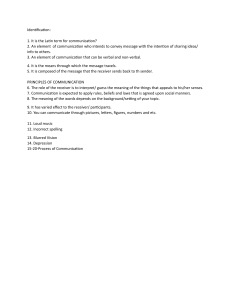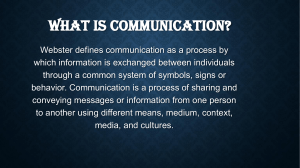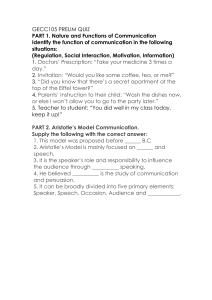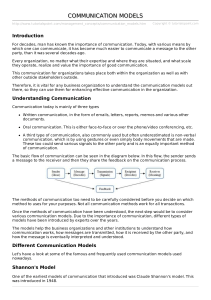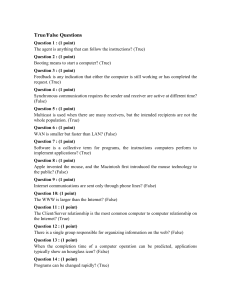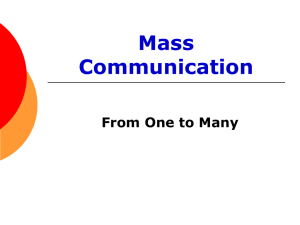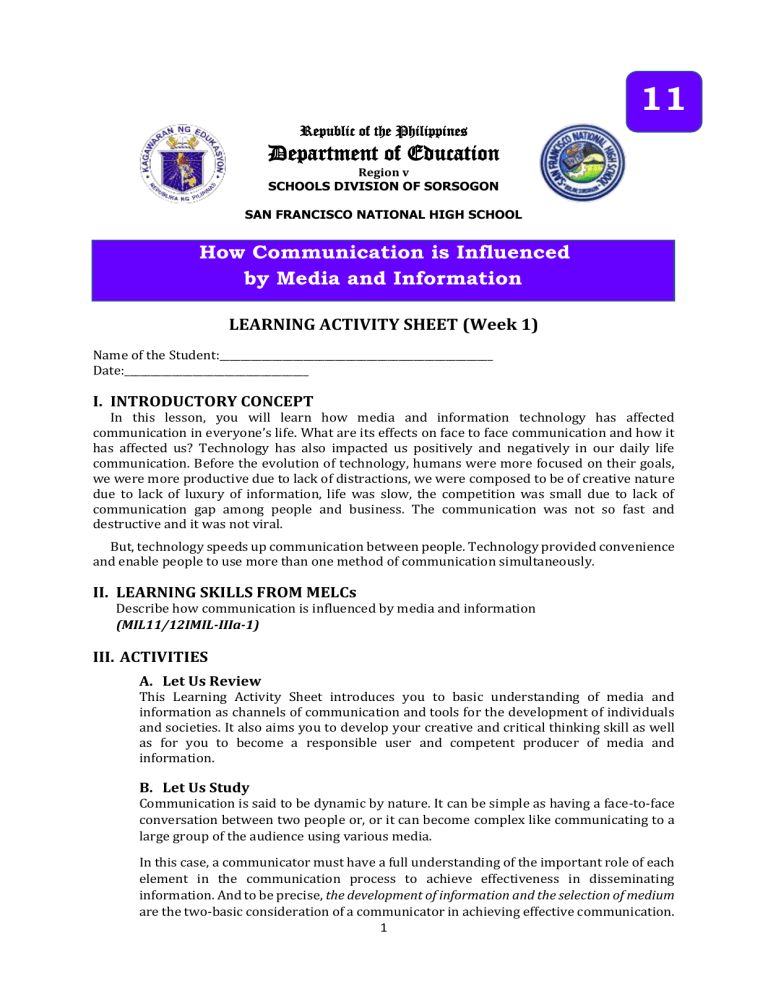
11 Republic of the Philippines Department of Education Region v SCHOOLS DIVISION OF SORSOGON School logo SAN FRANCISCO NATIONAL HIGH SCHOOL How Communication is Influenced by Media and Information LEARNING ACTIVITY SHEET (Week 1) Name of the Student:____________________________________________________ Date:___________________________________ I. INTRODUCTORY CONCEPT In this lesson, you will learn how media and information technology has affected communication in everyone’s life. What are its effects on face to face communication and how it has affected us? Technology has also impacted us positively and negatively in our daily life communication. Before the evolution of technology, humans were more focused on their goals, we were more productive due to lack of distractions, we were composed to be of creative nature due to lack of luxury of information, life was slow, the competition was small due to lack of communication gap among people and business. The communication was not so fast and destructive and it was not viral. But, technology speeds up communication between people. Technology provided convenience and enable people to use more than one method of communication simultaneously. II. LEARNING SKILLS FROM MELCs Describe how communication is influenced by media and information (MIL11/12IMIL-IIIa-1) III. ACTIVITIES A. Let Us Review This Learning Activity Sheet introduces you to basic understanding of media and information as channels of communication and tools for the development of individuals and societies. It also aims you to develop your creative and critical thinking skill as well as for you to become a responsible user and competent producer of media and information. B. Let Us Study Communication is said to be dynamic by nature. It can be simple as having a face-to-face conversation between two people or, or it can become complex like communicating to a large group of the audience using various media. In this case, a communicator must have a full understanding of the important role of each element in the communication process to achieve effectiveness in disseminating information. And to be precise, the development of information and the selection of medium are the two-basic consideration of a communicator in achieving effective communication. 1 Thus, in this lesson, the discourse on communication process and its elements will provide learners full understanding of the significant role of media and information in effective communication. In the communication process, participating individuals can be both sources of information and receiver of information. Information can be broadly defined as data, knowledge, or instructions through signals or symbols. As a source, participants are considered producers of information. The source should consider these two key components in effective communication. 1. Development of information 2. Selection of medium or media to be used in disseminating information Media are tools used by the source to disseminate information to the receivers. It can be broadcast media such as television and radio, print media such as newspapers and magazines, new media or Internet, and non-traditional media like film, literature, and outdoor media. In the development of information, the source must know how to generate information and package it with utmost accuracy and clarity for the ease of the receivers’ comprehension. The source should also think of the type of medium that will be used in disseminating information. Most of the source selects medium or media in conformity with the characteristics of the information users or receivers. Characteristics pertain to the media habit, lifestyles and preferences of the receivers. The Concepts and Nature of Communication According to Cambridge Academic Content dictionary, Communication is the process by which messages or information is sent from one place to another or the message itself. It can also be the exchange of information and the expression of feeling that can result in understanding. Communication transfers information through a medium or media. The intended audience will receive this information and process it and eventually turns it into knowledge that is useful to build and develop people and communities. The Types of Communication A. According to channels used: 1. Verbal Communication Verbal communication refers to the form of communication in which message is transmitted verbally; communication is done by word of mouth and a piece of writing. Verbal Communication can be subdivided into two, oral communication and written communication. 1.1 Oral Communication In oral communication, spoken words are used. It includes face-to-face conversations, speech, telephonic conversation, video, radio, television, voice-over the Internet. 1.2 Written Communication In written communication, written signs or symbols are used to communicate. A written message may be printed or written. 2 2. Non-verbal Communication Non-verbal communication is the sending or receiving of wordless messages. We can say that communication other than oral and written, such as gesture, body language, posture, the tone of voice or facial expressions, is called non-verbal communication. B. Types of Communication Based on Purpose and Style 1. Formal Communication Formal communication mostly takes place in professional settings. This is the type of communication practiced in corporate meetings, conferences, academic seminars, political sessions, and juridical proceedings. Its primary purpose is information dissemination to concerning parties that are involved in certain types of official businesses. 2. Informal Communication Informal communication is the most commonly used form of communication. It takes place in our daily interaction with one another. It happens in ordinary settings between friends, family, classmates, and practically anyone who wishes to speak with another. Simply put informal communication is casual talk. The Communication Process Communication process though complex can be simplified through communication models. The idea of communication as information processing was firmly established by Claude Shannon, a Bell telephone company research scientist who developed a mathematical theory of signal transmission. Information Source Receiver Transmitter Signal Received Signal Message Destination Message Noise Source Figure 1.1 Shannon & Weaver, The Mathematical Theory of Communication, Urbana II, University of Illinois Press, 1949, p. 98 In Shannon’s model, the information source typically refers to a person, who then sends a message with the use of a transmitter. This transmitter could be any instrument today, from phones to computers and other devices. The signals that are sent and received can vary depending on the method of communication. The box at the bottom called NOISE refers to any signals that may interfere with the message being carried. This again would depend on the method of communication. In this model, the receiver is equipment at the end of the line that delivers the message to its destination, or the person intended to receive the message. This is considered as the simplest model explaining the communication process. Due to its straightforward nature, this has been adapted into most communication subjects. It also set the foundation for further development by experts. 3 The Source or sender is the origin of the message. Message pertains to any information that is passed on through communication. Channel refers to the medium and how the information flows from the sender to the receiver. Receiver refers to the listener of the message. Wilbur Schramm adapted Osgood’s theory to develop a circular communication model. In this model, both the sender and receiver take turns in becoming the encoder and decoder. Figure 1.2 Schramm, The process and Effects of Mass Communication, Urbana II, University of Illinois Press, 1954 The Role of Media and Information in Effective Communication Most households have televisions, cars have radios, many take their morning coffee with a newspaper, everybody has a smartphone, and computers are everywhere. Indeed, the media has become a constant in the lives of everyone. It is not surprising that because of this, media and information plays a vital role in effective communication. It makes the world a smaller place Today, at any given point in time, a person can be connected to anyone else in the world. Communication between two parties from opposite sides of the world is now possible. It makes communication convenient Gone are the years where people send telegrams and snail mails to one another. Now two people communicate with another without the long wait for replies or the worry that their messages won’t be received in a timely manner. With the existence of email and various messaging sites and apps, communication has become faster and easier. It shapes public opinion In his book Setting the Agenda, Maxwell McCombs explained that mass media shapes public opinion. Owing the wide reach, not to mention the perceived credibility of the media, they can sway the opinion of their audience according to the message they convey. The Media and Information Producers and Users 4 Various headhunter websites describe Media Producers as someone who oversees projects (e.g. films, TV shows) from conception to completion and may also be involved in the marketing and distribution process. Media users refer to the audience or consumers of media. They are the receivers of information disseminated by media producers. The producer and user can alternatively act as both in the process of communication. The Media Habits, Lifestyles, and Preferences Users consume media according to their habits, lifestyles, and preferences. These three determine the types and forms of media that an individual is likely to patronize. Individual’s choice of media platform, use of platform, and frequency of usage determine his or her media persona. A person’s normal use of media pertains to media habits. For instance, most people regularly grab and read newspapers every morning to get the latest information on the happenings in the country. Media lifestyle, on the other hand, refers to a person’s use of media based on his or her lifestyle. This includes the styles, interests, and attitudes of individuals. The media preference of an individual may be affected by the accessibility, availability, affordability and convenience of the media platform. C. Let Us Practice Exercise 1. Directions: Make a throwback of your past week activities. Record your use and interaction with media and information providers (such as internet, YouTube, Facebook, TV, radio, newspaper, books, etc.). Using the prescribed table format below, indicate how many hours were spent engaged in each one. You may not have to be exact, instead, estimate the number of hours you spend each week. Cite at least Five (5) media and information providers. Weekly Interaction Log with information and Information Providers Media or Information Provider Number of Hours Spent in a Week Questions: 1. Which media provider did you spend the most time? 2. What roles do media play in your life? (entertainment, learning, communication, etc.). In no less than 4 paragraphs, give your reasons why those roles of media affect your life. D. Let Us Remember Communication, the exchange of ideas, has become faster, easier, and more efficient due to advances in technology. Cell phones, social networking websites, e-mail, and instant messaging are examples of technology which enable communication. Information technology plays a crucial role in using technology to communicate. 5 E. Let Us Practice More Exercise 2. Directions: Based on studies, it is now a fact that citizens of the 21st Century are dependent on technology. As a technology-inclined citizen, how would you go along a scenario; where, upon waking up one day, you found no more media, internet, libraries, and cell phones. In addition, all newspapers and magazines have disappeared while radio stations and TV channels have totally shut down. Using the given questions below, make an analysis that addresses the problem scenario. Write your answers in brief and concise sentences. • How would you be informed of anything now? • How would you share information and communicate news and events? • What would happen with the decisions you usually make? • How would it affect the way you live? • What would society lose with this kind of problem F. Evaluation Poster Analysis: Write your answer on your worksheet Guide Questions: 1. What is the message of this poster? 2. Do you agree with the message? Why or why not? IV. RUBRIC FOR SCORING (if necessary) 6 V. ANSWER KEY Exercise 1: Answers may vary Exercise 2: Answers may vary Evaluation: Answers may vary VI. REFERENCES Gonzales, Edward D. (2016). Media and Information Literacy, Manila, Philippines: JFS Publishing Services. Benolaria, Romie G. (2020). Media and Information Literacy Alternative Delivery Mode Module- Division of Negros Oriental. Prepared by: LEA G. NOVELA Senior High School Teacher II Reviewed by: RINO G. ORR Senior High School- Assistant Principal II Approved by: RAMILO G. FURAQUE School Principal I 7
